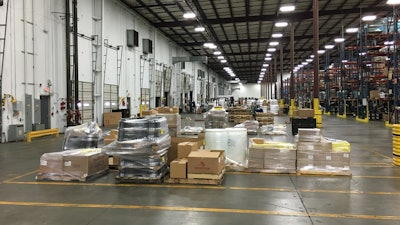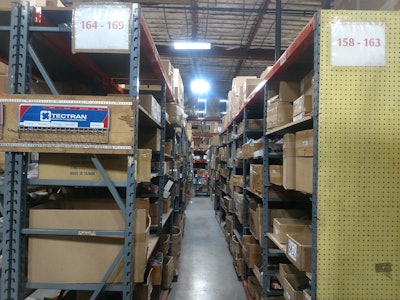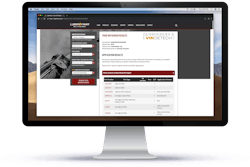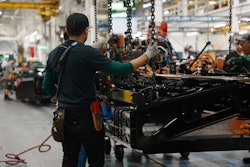
[This article was originally published in 2019 by Trucks, Parts, Service. It has been updated to include more timely information.]
Though the parts counter and outside sales representatives are the face of the aftermarket parts distributor, meeting with customers in person or answering their calls, the warehouse is the foundation of the business. Thus, optimal warehouse design is crucial for efficient and safe operations.
“We are always striving to improve our warehouse and logistic operations. Warehouse optimization creates efficiency. The quicker, more accurate and less onerous the process, the greater the customer satisfaction and bottom-line improvement,” says Andy Robblee, president, Six Robblees’.
Warehouse optimization entails maximizing all facets of the operation, such as inventory flow, product accuracy and availability; asset and cube utilization, which is total space used; team member safety; and productivity, says Reggie Jacobs, vice president, distribution and logistics, TruckPro.
“These are the components of the operation that enable us to deliver the quality that is expected by our customers. Without a properly optimized facility we would not be able to deliver quality results, while being good stewards of the capital that has been invested in the operations,” says Jacobs.
 Warehouse optimization entails maximizing all facets of the operation, such as inventory flow, product accuracy and availability, cube utilization, employee safety and productivity.TruckPro
Warehouse optimization entails maximizing all facets of the operation, such as inventory flow, product accuracy and availability, cube utilization, employee safety and productivity.TruckPro
Some parts providers have trained their warehouse employees to treat inventory as they would money.
“I keep my money organized and accounted for; our inventory needs to be treated the same way because that’s what it is,” says Adam Diecks, vice president of sales and marketing, Point Spring & Driveshaft.
“Treat it like money and get everyone on that same kind of mindset because you can lose everything if you lose inventory,” Diecks says. “If a customer calls and you say you have [the part] but then you can’t find it, you lose the sale. We’re a warehouse distribution company and an organized and efficient warehouse is key to everything we do.”
Fleet Brake Parts & Service says it treats inventory similarly.
“We consider our warehouses vaults. Every item in our locations is cash and we need to manage them accordingly,” says John Bzeta, president, Fleet Brake Parts & Service. “When managing this ‘cash’ we try and imagine we are like a Best Buy store handling televisions, iPads and computers. Our teams then understand how important our shipments and inventory are.”
Optimization requires planning
Designing a warehouse that optimizes efficiency involves seemingly countless factors that need to be addressed, such as frequency of picks, weight, part size and proximity, says Robblee.
For example, commonly sold items should be placed in locations that are easy to reach and kept closer to receiving and shipping locations to cut down on travel time, whether it is by forklift or hand, he says.
“Weight plays into it as well. It is far safer to put heavy items lower to the ground. Is the product in a nice small box or a cubed pallet or does it exceed the height, length or width of standard bins? Outsized items typically find themselves stored in remote areas, which is great for less frequent picks, but not so great for popular items,” Robblee adds.
Jacobs stresses the importance of data to analyze and determine product placement in the warehouse, such as most commonly purchased items and picking strategy for each product.
“At the same time you must understand the systems you are using to deliver the necessary results. Your ability to leverage the systems’ capabilities enable you to design a process that supports the inventory flow and accuracy. You want to limit the amount of time and effort associated with each transaction,” he says.
Shrinkage, another factor in running a warehouse, can be minimized by implementing strong receiving procedures, says Bzeta. However, he adds human error is far more common than theft regarding missing inventory.
“Vendors are not as efficient or advanced as retail suppliers, so reconciliation of errors need to be managed carefully and quickly to ensure correct stock counts,” he adds.
Putting design into action
In 2016, Diecks was tasked with managing Point Spring & Driveshaft’s largest warehouse. One of the first projects he tackled was organizing the facility. A change he made early in that process was simple, comparatively, but has made a huge difference, he says.
“We spent a ton of time labeling the shelves,” Diecks says, admitting it was one of the areas the company was weak. “We had situations where parts were moved and a new label was stuck over an old label or a label was never changed.”
Diecks says he and some employees worked many late nights in the warehouse scraping off old, hand-written stickers from shelves and replaced them with printed magnetic labels.
“I want everything typed so it is easy to read. 5s, 3s and Bs can get confusing when looking at them from a distance. With magnetic labels, when you move the part, you can move the label,” he says.
Diecks says Point Spring & Driveshaft also reorganized bins product line by product line, corrected instances where parts had been improperly stocked and numbered the aisles in the warehouse. From there, the company updated its computer system to account for the location of every part in its inventory so when an order is printed out, it includes the aisle number and bin location.
“I was trying to remove the attitude of ‘I’ve been here 20 years; I know where everything is.’ I want the new guy that starts tomorrow to be able to look on a printout and be able to find the part,” Diecks says. “From an organizational standpoint, being able to quickly and easily know where the parts are saves you time — and time is money, always. That was a big project that has paid off.”
Warehouse design, including the showroom, can be improved with visual indicators, says Bzeta. Clearly marked shelves, along with images for certain parts, can lessen the chances of employees or customers picking an incorrect part.
“Larger retailers, like Home Depot, know how to set up inventory. There will be an image of the part on the shelf or the pallet rack so you know exactly what you are getting,” Bzeta says. “I rarely see this commitment to organization in our industry.”
 Six Robblees’ is shrinking the aisleway gap to fit more racking in its warehouse — a move made possible by improved technology that has reduced the footprint and turning radius of aerial lifts.
Six Robblees’ is shrinking the aisleway gap to fit more racking in its warehouse — a move made possible by improved technology that has reduced the footprint and turning radius of aerial lifts.
Technology plays a big role in optimizing the warehouse. Barcoding, RFID, lifting equipment and robotics all can enhance a good warehouse layout, Robblee says. “We [shrink] aisleway gaps to fit more racking in our warehouse due to smaller footprint and turning radius of aerial lifts made possible by fantastic technology upgrades,” he says.
Robblee adds hiring quality warehouse personnel can enhance warehouse productivity. “Contrary to the popular belief that any warm body will do, a good warehouse employee knows how to stock shelves correctly, pick inventory quickly and accurately, discover and correct mistakes and avoid injury,” he says.
TruckPro has implemented workload planning tools, production standards and a production system. Each are tied to time and attendance systems that track productivity and the utilization of the staff in each area of the operation.
In addition, the company has introduced employee performance incentives focused around the quality of work employees do. Recognition for the programs are tracked and reported daily and incentives are awarded quarterly, Jacobs says.
Additional measures TruckPro has implemented include changing the way the company manages the inventory cycle process.
“Not all inventory is moving at the same rate and we do not count it all on the same frequency. The results of our cycle process have had a huge impact on our ability to deliver very high fill rates out of the distribution center,” he says.
And, though the company has standard operating procedures, Jacobs says TruckPro relies more heavily on work instructions. “These documents allow us to execute our training programs more consistently. They are very specific to the workflows and we are able to adjust them as the business evolves,” he says.
“Optimizing a facility requires that you consider many factors. All of the processes we create in a facility are designed to achieve a high level of customer satisfaction and to be easily repeatable,” Jacobs says. “Designing a facility and the processes that support your customers are key to any successful operation. As such, we are very focused on the end-to-end processes of the operation.”
Consider a master warehouse
Another way to optimize warehouse optimization is by having a parts master warehouse. One of the biggest positives of having a master warehouse is the speed of getting products to customers if those products aren’t available at all, or in the quantity desired, at the store level.
“By having a centralized distribution center, the time it takes to fill an order can be cut down dramatically, anywhere between 30 to 70 percent,” says HDA Truck Pride (HDATP).
[RELATED: Why you should consider a parts master warehouse]
HDATP says other advantages of a master or centralized warehouse is more simplicity working with vendors because product is being purchased for many locations but only be delivered to one, simplifying administrative work, such as payables, receiving process, etc. It also allows you take advantage of different buying opportunities.
“First and foremost, being able to manage the freight programs” is a benefit of a master warehouse, says Robblee. “If you hit certain volumes with certain vendors, they will prepay freight.
Another advantage of a central warehouse is employee hiring efficiency. Instead of hiring employees to handle distribution at each location, fewer personnel can be hired to run the central hub, he says.









